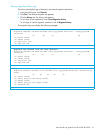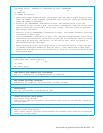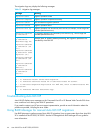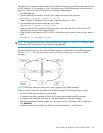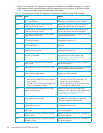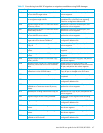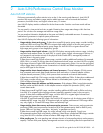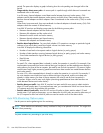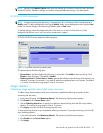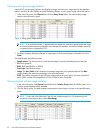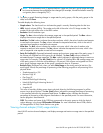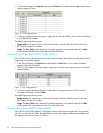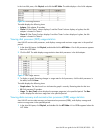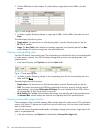
Auto LUN XP user guide for the XP12000/XP10000 49
2 Auto LUN/Performance Control Base Monitor
Auto LUN XP statistics
Disk arrays automatically collect statistics twice a day (in the morning and afternoon). Auto LUN XP
monitors disk arrays and obtains usage statistics about resources such as front-end and back-end
processors, hard disk drives, and logical volumes every 15 minutes.
Auto LUN XP displays statistics collected for the last three months. Statistics over three months old are
discarded.
You can specify a time period and view a graph illustrating how usage rates change within that time
period. You can also view average and maximum usage rates.
You can analyze information displayed on the pane and identify overloaded resources. If necessary, take
load-balancing measures to improve system performance.
Auto LUN XP displays the following types of information:
• Usage statistics about parity groups. If data shows overall high parity group usage, consider installing
additional HDDs and using Auto LUN XP to migrate high-usage volumes to the new parity groups. If
monitor data shows unbalanced parity group usage, use Auto LUN XP to migrate volumes from
high-usage parity groups to low-usage parity groups.
• Usage statistics about logical volumes. Auto LUN XP displays average and maximum usage, including
sequential and random access, for each LDEV in a parity group. Logical volume usage is the time in
use (sequential and random access) of the physical drives of each LDEV, averaged by number of
physical drives in the parity group.
If data shows overall high logical volume usage, consider installing additional hardware (for example,
HDDs, DKAs, or cache). If monitor data shows unbalanced volume usage, use Auto LUN XP to migrate
high-usage volumes to higher HDD classes and/or lower-usage parity groups. You can also use logical
volume usage data to analyze access characteristics of volumes and determine appropriate RAID level
and/or HDD type for the volumes.
• Usage statistics about channel adapters and channel processors. Channel adapters (CHAs) process
host commands and control data transfer between hosts and cache. A channel adapter contains
multiple channel processors (CHPs), which process host commands and control data transfer.
If data shows overall high CHA usage, consider installing additional CHAs. If data shows unbalanced
CHP usage, consider moving some devices defined on overloaded ports to ports with lower-usage
CHPs to balance front-end usage.
• Usage statistics about disk adapters and disk processors. Disk adapters (DKAs) control data transfer
between cache and disk devices. A disk adapter contains multiple disk processors (DKPs), which
control data transfer.
If data shows overall high DKP usage, consider installing additional HDDs and/or DKAs and using
Auto LUN XP to migrate high-write-usage volumes (especially sequential writes) to the new parity
groups. If data shows unbalanced DKP usage, use Auto LUN XP to migrate logical volumes from
high-usage parity groups to low-usage parity groups.
Auto LUN XP cannot estimate DKP usage. Use Auto LUN XP migration only for obvious cases of high or
unbalanced DKP usage. Auto LUN XP migration might not improve performance if DKP usage values
vary only slightly or if overall DRR usage values are relatively high.
• Usage statistics about data recovery and reconstruction processors. Data recovery and reconstruction
processors (DRRs) are microprocessors located on DKAs that generate parity data for RAID-5 parity
groups. DRRs use “old data + new data + old parity” to generate new parity.
If data shows overall high DRR usage, this might indicate a high write penalty. Consult your
HP representative about high write penalty conditions. If data shows unbalanced DRR usage, consider
using Auto LUN XP to relocate volumes to balance DRR usage within the disk array.
• Write pending rate. The write pending rate indicates the ratio of write-pending data to cache memory
capacity. The Auto LUN pane displays average and maximum write pending rates for the specified time



